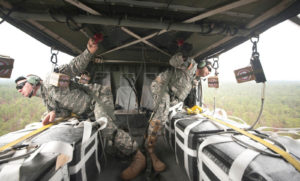
As the war in Afghanistan aptly illustrates, combat units deployed in remote locations struggle to keep supply lines open for food, water, ammunition and medical supplies. Mountainous regions of Afghanistan can be re-supplied by helicopter drop; unfortunately, 50–60 percent of the supplies are damaged after they hit the ground. “We originally received this need from the field, specifically for emergency ammunition re-supply,” says Bob Forrester, an engineer with the U.S. Army’s Armament Research, Development and Engineering Center (ARDEC). “Essentially, we worked the ammunition survivability piece, and NSRDEC [Natick Soldier Research, Development and Engineering Center] worked the aerial delivery piece.”
The combined effort led to the Enhanced Speed Bag System (ESBS), which includes a hands-free linear brake, rope and padded cargo bag that holds up to 200 pounds and can be dropped from 100 feet. The bag lands padded side down because the rope slows it down just enough to keep it oriented, says Forrester. A test conducted with six ESBS bags at Fort A.P. Hill in Virginia showed that cargo loads dropped 100 feet from a crane arrived intact 98 percent of the time. Subsequent evaluation prompted ARDEC to recommend immediate fielding of the ESBS to deployed soldiers. The U.S. Army’s Rapid Equipping Force (REF), a one-stop shop for validating product requirements, purchasing and accessing flexible funding, put the ESBS on a fast track.
In December 2014, the aerial delivery experts from NSRDEC led a training event on the Rhode Island Air National Guard Base to train soldiers (especially REF trainers and the U.S. Army Mountain Warfare School) to pack, rig the release system, drop and unpack the ESBS, in this case filled with drinking water. “We lost only one water bottle out of more than 240 and additional 5-gallon jugs dropped,” says Jason Miller, training consultant from REF. Read more about the ESBS.
 TEXTILES.ORG
TEXTILES.ORG


